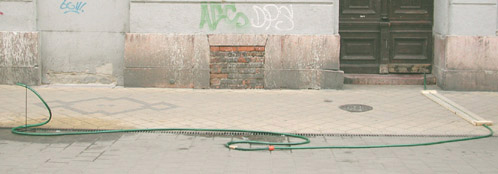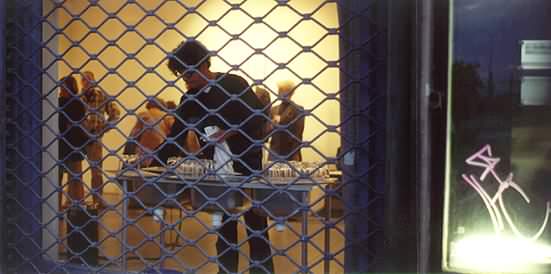

0vid Uman*:
Elmentem, láttam, éltem, most itt vagyok újra…
Simon P. Miklós kiállítása a Liget Galériában
Simon P. Miklós életrajza alapján sikeres ember. A nehézségekkel megküzdő
magyar emigráns elérte célját, művész lett Amerikában.
Első ránézésre így tűnik, de a mostani kiállításra
készült munkák alapján bonyolultabb, ellentmondásosabb, árnyaltabb kép
bontakozik ki. A sikeres, kemény „túlélő” kép felszíne mögött érzékeny
tartományok rejtőznek. Ennek a kettősségnek a feltérképezésén, feldolgozásán,
összeépítésén dolgozik.
Simon P. Miklós tradicionális stúdiumokon képzett szobrász, de munkássága
a performence-ot is beleértve több területet ölel föl.
1960-ban született Magyarországon és 1981-ben emigrált
az USA-ba. Egyetemi diplomát szerzett a The School of Art Institute of
Chicago-n (SAIC), majd 1991-ben megkapta a Master of Fine Art (MFA) címet
a University of Notre Dame-tól. Folyamatos résztvevője hazai és nemzetközi
kiállításoknak. Több egyetemen tanított és tanít – SAIC, University of
Notre Dame – jelenleg a Columbia College in Chicago tanári karának tagja.
Feleségével és két gyermekével Chicagóban él.
Az életrajzi adatok természetesen még nem adnak választ arra a kérdésre,
hogy ki is Simon P. Miklós, a művész? Az Elmentem, láttam, éltem, most
újra itt vagyok című kiállítása erre tesz kísérletet. A kiállítás szeptember
11-én nyílik Magyarországon, Budapesten, a Liget Galériában. Ez már a negyedik
bemutatkozása szülőhazájában és az eddigi legkomolyabb vállalkozása.
Amikor Simon 1981-ben elhagyta az országot, azt
még mindig a szovjet típusú kommunizmus uralta. Szerencsésnek számítottak,
akik elmehettek. Történetesen közéjük tartozott. Szerencsés volt. Amerikában
hamar megszokta az új, szabad világot, és tudta, hogy útja visszafordíthatatlan.
Azt viszont még nem tudta, akkor, hogy amit lezárt és otthagyott a múltjában,
mintha meg is halt volna benne. Mintha nem lett volna többé egész, mintha
állandósult volna a hiány. Az idő múlásával csak nőtt a szakadék az új
és a régi, a gyermek és felnőtt, a magyar és az amerikai világ között.
Az egykori egység, az osztatlan személyiség, a belső azonosság megtapasztalása,
elérése kísérti újra és újra.
A kiállítás fő motívuma épp ez a hiány illetve annak
kiegyenlítésére való törekvés. A címek némelyike közvetlenül, részben közvetetten
utal erre. Például „A félbevágott ember öltönye, aki túlélte”. A mesterien
szabott öltöny, amely egy hosszában kettéhasított emberre készült, gyomorba
vágó látvány. Paradox igazsággal szembesülünk és a módszer közeli rokonságot
mutat a zen buddhizmus koanjával. Az eljárás bepillantást enged a művész
személyes világába. Ez a mű önarckép: melankolikus öngratuláció a sikeres
túlélőnek.
„Az én saját szigetem” a sziget fogalmát helyezi
új kontextusba, egyben a tulajdoni igény bejelentése némi humoros felhangot
ad. Bejelenti tulajdonjogát és figyelmezteti is a látogatót: Belépni tilos!
Vagyis magánterületről van szó. Rejtekhely, amit maga teremtett magának.
De létezik ilyen hely a valóságban? „Az én saját szökőkutam” hasonló módon
kéri a látogató megértését. Biztos, nyugodt, belső helyet keres. Olyan
magántulajdonnak képzeli, ahol egyedül lehet. Magával lehet? A spirituális
utazások színtereit, ahol a lélek megpihen.
- 2 -
A performance a kiállítás része. A művész komolyan,
módszeresen poharakat mos. A gesztust magyarázza, hogy első megélhetési
forrása Chicagóban a mosogatás volt egy magyar étteremben. A pszichológusok
gyakran használnak eszközként elfelejtett-elfojtott eseményeket a széteső
személyiségkép újra építéséhez.. Az esemény pillanatnyi, érzéki átélése
lehetőséget teremt a múlt és a jelen közt húzódó szakadék áthidalására.
A művészet az az eszköz, amely segít helyreállítani azt a bizonyos egységet.
A performance maga cselekvés, a teljessé vált, megjelenített
idő. Nem megérteni kell, hanem átélni, a szakralitás szabályai szerint.
Mint az igazi térdhajtás – nincs szükség mások jóváhagyó megértésére, egyetértésére.
Az egyes művek önálló értelmezési tartománnyal bírnak, amik valamilyen
összefüggésben állnak egymással, de semmiképpen sem életrajzi ihletettségű
„életképek”. Legalább annyira vonatkoznak ránk, mint alkotójukra. Ha akarjuk,
ha nem, részesei lettünk egy metafizikus utazásnak Simon vezérletével.
Elutaztunk, visszatértünk és jó esetben magunkat találtuk a végén.

0vid Uman*:
I went, I saw it, I survived it, I'm back just for a
short visit
By taking a quick glance at Miklos Simon's curriculum vitae one can
conclude that his life is yet another success story of a hard working immigrant
who made it as an artist in America.
From a strictly material point of view this happen
to be true. But that's only half of it.
A closer look, at the work he has just completed
for an upcoming exhibition, tells a much larger story. Beneath the veneer
of this outwardly rugged individual lies a fragile and tormented soul hard
at work trying to reconcile the schism of his inner self.
Miklos Simon, is a classically trained sculptor who works in a variety
of media including time-based performance work. He was born in 1960 in
Hungary, and immigrated to The United States in 1981. He graduated
from The School of The Art Institute of Chicago (SAIC), and went on to
University of Notre Dame from where he received a Master of Fine Arts (MFA)
in 1991. Since then he has continued to make and exhibit work both nationally
and internationally. He has also taught at SAIC, and The University of
Notre Dame. Currently he serves on the faculty of Columbia College in Chicago.
He lives in Chicago with his wife and two children.
Knowing all this of course, answers much of the :"what" is Miklos Simon?
But nothing of the :"who" is Miklos Simon? This current exhibition titled:
I went, I saw it, I survived it, and I am back just for a short visit,
is an attempt toward answering this question.
One of the things worth noting from the beginning
is that the show just mentioned, is scheduled to open on September 11,
2003, in Budapest, Hungary.
The artist's native land. This is his forth major
exhibition in Hungary and by far the most comprehensive in the scope of
the work.
When Simon left the country in 1981, Hungary was
still suffering under the repression of a soviet inspired communism. Those
who managed to get out were considered fortunate. He happened to be one
of them. He was lucky. Once in America, he embraced this new found freedom
and knew that he will never return. What he didn't know however, was that
at the same time, somewhere deep inside, a part of him began to die. He
was no longer 'whole'. A part of him was left behind. And with every day
that passed this rift was widening.
The gap between the old world and the new, between
the child and the man, between the hungarian and the american grew larger
and larger. Having felt complete once, having known an undivided identity
in the past, and having experienced a coherent, integral self up until
now, he will long for this lost state of being for the rest of his
life.
This feeling of loss along with the profound longing for a reconciliation
haunts much of this current exhibition. Some of the titles make clear reference
to this, while others do so covertly.
For example, the conundrum posed by the appearance
of the actual piece itself and that of its title in: The suit of the man
who was cut in half and survived it. is dizzying. The obvious contradiction,
a suit tailored as if meant to be worn by someone split in half, creates
a state of nausea. We are faced with an impossible "truth". This koan,
so utterly irreconcilable with our modes of perception forces upon us a
fleeting insight into who Simon is.
The work is a self-portrait. And it's title it's
not a joke at our expense. But rather, the artist's, melancholic way, of
congratulating himself of his own come through. This sort of rubber band
semantics occur again and again throughout show.
In My private island the sense of alienation conjured up by the
'island' is veiled in humor through the artist's use of the word
my. He is claiming proprietorship and at the same time serves the
audience with a warning: "No trespassing". This is his own private domain
. His refuge. He has created it and it is for him alone. But really, is
there such a place? Similarly, My private fountain, begs our understanding
of the subject's self-sufficiency by again employing oblique humor. The
allusion to places of leisure and repose in both of these works gives us
the impression that Simon is reaching for an "interior" space where he
can be alone. This is the desperate cry of a man in need of a spiritual
vacation. His soul needs rest.
In the performance element of this show, the artist
is seen slowly and methodically washing a number of glasses. The
significance of this act can be easily lost if one doesn't know that Simon's
first means of subsistence in America were the wages he received from washing
glasses in a hungarian restaurant. Therapists often use past regression
as a tool in helping patients recovering "lost" parts of themselves. Here,
by revisiting this temporal outpost the artist is constructing a bridge
back across the distance separating him from the other self left behind.
He is trying to earn him back through a sacrificial artwork. This act,
the very performance, is his wage. He has now completed the cycle. There
is no need for anyone else to understand. This is a sacred act. A
kneeling within. And as such does not require the understanding of
those around to be valid.
The works in this Exhibition are not to be read
as a narrative. They do not suppose to tell the story of Miklos Simon.
They are more like the faces of a five sided "coin". Each standing on it's
own while being part of a coherent whole. Each a looking glass in which
we can see not only him but us as well.
In the end we can not help but feel like we've been
taken along on Simon's own metaphysical journey and came back having
found ourselves.